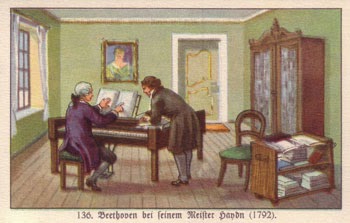
HARMONIC EXPANSIONS
CHAPTER 6: PERIODS AND CADENCES
6.5 Half Cadences in Continuous Periods
 |
 |
 |

Beethoven dedicated the sonata excerpted on the right to his one time teacher Joseph Haydn. One of their lessons is depicted on the left. Beethoven and Haydn's relationship is interesting since, despite the dedication, they don't seem to have gotten along. |
The two phrases above which begin Beethoven's Piano Sonata Op.2 No.3 end with half and perfect authentic cadences. This has been true of many previous examples, but in the above illustration, the harmony at the beginning of phrase 2 does not interrupt the drive from V at the half cadence to I. Instead the harmony at the beginning of phrase 2 continues the dominant harmony so that an overall tonic-dominant-tonic fundamental harmonic progression spans both phrases (see the bottom set of Roman numerals). This expansion of dominant harmony results in what is called a continuous period, a period with one complete harmonic progression in the space of two phrases instead of one phrase.
The above example is considered a parallel period because the phrases are very similar to each other. Their rhythms are identical and the only differences in pitch are that the notes at the beginning of phrase 2 are a step higher than those at the beginning of phrase 1.
|
The video to the left shows a continuous period with Half and Perfect Authentic cadences. Notice the absence of double slashes at the end of phrase 1 and the long deep level dominant which continues from one phrase to the next.
|
| Movement 2 of the Winter concerto from Vivaldi's The Four Seasons also has a continuous period as a result of dominant harmony which is expanded beyond a half cadence. |
 |
 |
 |
 |
Comments? Click here. |



